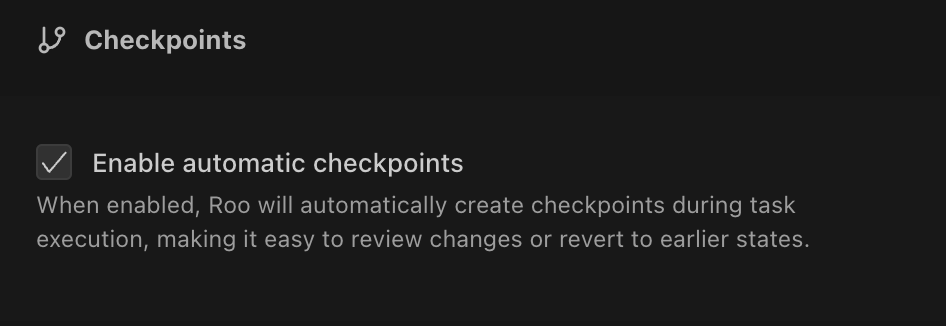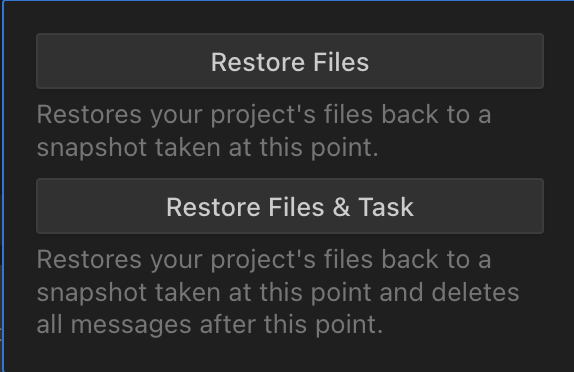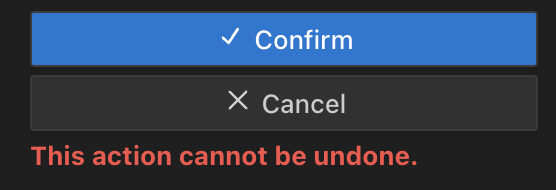Checkpoints
Checkpoints automatically version your workspace files during Roo Code tasks, enabling non-destructive exploration of AI suggestions and easy recovery from unwanted changes.
Checkpoints let you:
- Safely experiment with AI-suggested changes
- Easily recover from undesired modifications
- Compare different implementation approaches
- Revert to previous project states without losing work
- Checkpoints are enabled by default.
- Git must be installed for checkpoints to function - see installation instructions
- No GitHub account or repository is required
- No Git personal information configuration is needed
- The shadow Git repository operates independently from your project's existing Git configuration
Configuration Options
Access checkpoint settings in Roo Code settings under the "Checkpoints" section:
-
Open Settings by clicking the gear icon → Checkpoints
-
Configure checkpoint behavior:
- Check or uncheck the "Enable automatic checkpoints" checkbox
- Adjust the "Checkpoint initialization timeout" (10-60 seconds, default: 30s)

Checkpoint Initialization Timeout
Controls how long the system waits for checkpoint initialization to complete before showing a warning. If your project has many files or is on slower storage, increasing this timeout can prevent premature warnings.
- Range: 10-60 seconds
- Default: 30 seconds
- When to increase: Large projects, slow disk I/O, or network-mounted directories
- Location: Settings → Checkpoints → "Checkpoint initialization timeout"
How Checkpoints Work
Roo Code captures snapshots of your project's state using a shadow Git repository, separate from your main version control system. These snapshots, called checkpoints, are automatically created before file modifications occur, ensuring you can always undo unwanted changes. Checkpoints are recorded when tasks begin and before file modifications. They are not automatically created before command execution.
Checkpoints are stored as Git commits in the shadow repository, capturing:
- File content changes
- New files added
- Deleted files
- Renamed files
- Binary file changes
Working with Checkpoints
Checkpoints are integrated directly into your workflow through the chat interface.
Checkpoints appear directly in your chat history:
-
Task checkpoint marks your starting project state

-
Regular checkpoints are created before file modifications, allowing easy undo of any changes

Each checkpoint provides two primary functions that are always available in both the chat history and checkpoint menu:
Viewing Differences
To compare your current workspace with a previous checkpoint:
-
Locate the checkpoint in your chat history or open the checkpoint menu
-
Click the checkpoint's
View Differencesbutton
-
Review the differences in the comparison view:
- Added lines are highlighted in green
- Removed lines are highlighted in red
- Modified files are listed with detailed changes
- Renames may not always be detected; diffs reflect per-file changes between commits
- New or deleted files are clearly marked

Restoring Checkpoints
Restore options are always visible in checkpoint buttons and dialogs, regardless of whether changes are detected. This ensures you can always revert to any checkpoint state.
To restore a project to a previous checkpoint state:
-
Locate the checkpoint in your chat history or checkpoint menu
-
Click the checkpoint's
Restore Checkpointbutton (always visible)
-
Choose one of these restoration options:

-
Restore Files Only - Reverts only workspace files to checkpoint state without modifying conversation history. Ideal for comparing alternative implementations while maintaining chat context, allowing you to seamlessly switch between different project states. This option does not require confirmation and lets you quickly switch between different implementations.
-
Restore Files & Task - Reverts both workspace files AND removes all subsequent conversation messages. Use when you want to completely reset both your code and conversation back to the checkpoint's point in time. This option requires confirmation in a dialog as it cannot be undone.

-
Limitations and Considerations
- Scope: Checkpoints only capture changes made during active Roo Code tasks
- External changes: Modifications made outside of tasks (manual edits, other tools) aren't included
- Large files: Very large binary files may impact performance
- Unsaved work: Restoration will overwrite any unsaved changes in your workspace
- Timing: Checkpoints are created before changes are applied, providing a safety net for all modifications
Technical Implementation
Checkpoint Architecture
The checkpoint system consists of:
-
Shadow Git Repository: A separate Git repository created specifically for checkpoint tracking that functions as the persistent storage mechanism for checkpoint state.
-
Checkpoint Service: Handles Git operations and state management through:
- Repository initialization
- Checkpoint creation and storage
- Diff computation
- State restoration
-
UI Components: Interface elements displayed in the chat that enable interaction with checkpoints.
Restoration Process
When restoration executes, Roo Code:
- Performs a hard reset to the specified checkpoint commit
- Copies all files from the shadow repository to your workspace
- Updates internal checkpoint tracking state
Storage Type
Checkpoints are task-scoped, meaning they are specific to a single task.
Diff Computation
Checkpoint comparison uses Git's underlying diff capabilities to produce structured file differences:
- Modified files show line-by-line changes
- Binary files are properly detected and handled
- Rename detection may be limited; diffs focus on file content changes between checkpoints
- File creation and deletion are clearly identified
File Exclusion and Ignore Patterns
The checkpoint system uses intelligent file exclusion to track only relevant files:
Built-in Exclusions
The system has comprehensive built-in exclusion patterns that automatically ignore:
- Build artifacts and dependency directories (
node_modules/,dist/,build/) - Media files and binary assets (images, videos, audio)
- Cache and temporary files (
.cache/,.tmp/,.bak) - Configuration files with sensitive information (
.env) - Large data files (archives, executables, binaries)
- Database files and logs
These patterns are written to the shadow repository's .git/info/exclude file during initialization.
.gitignore Support
The checkpoint system respects .gitignore patterns in your workspace:
- Files excluded by
.gitignorewon't trigger checkpoint creation - Excluded files won't appear in checkpoint diffs
- Standard Git ignore rules apply when staging file changes
Git LFS Patterns
Patterns defined in your workspace's .gitattributes for Git LFS are read and added to checkpoint exclusions. This helps avoid tracking large LFS-managed assets in the shadow repository.
.rooignore Behavior
The .rooignore file (which controls AI access to files) is separate from checkpoint tracking:
- Files excluded by
.rooignorebut not by.gitignorewill still be checkpointed - Changes to AI-inaccessible files can still be restored through checkpoints
This separation is intentional, as .rooignore limits which files the AI can access, not which files should be tracked for version history.
Nested Git Repositories
If nested Git repositories are detected in your workspace, checkpoints are disabled. You'll receive a clear notification when checkpoint initialization fails due to nested repositories. Remove or relocate nested repositories to enable checkpoints.
Concurrency Control
The extension prevents duplicate checkpointing within a single streaming operation. There is no dedicated Git operation queue.
Git Installation
Checkpoints require Git to be installed on your system. The implementation uses the simple-git library, which relies on Git command-line tools to create and manage shadow repositories.
macOS
-
Install with Homebrew (recommended):
brew install git -
Alternative: Install with Xcode Command Line Tools:
xcode-select --install -
Verify installation:
- Open Terminal
- Type
git --version - You should see a version number like
git version 2.40.0
Windows
-
Download Git for Windows:
- Visit https://git-scm.com/download/win
- The download should start automatically
-
Run the installer:
- Accept the license agreement
- Choose installation location (default is recommended)
- Select components (default options are typically sufficient)
- Choose the default editor
- Choose how to use Git from the command line (recommended: Git from the command line and also from 3rd-party software)
- Configure line ending conversions (recommended: Checkout Windows-style, commit Unix-style)
- Complete the installation
-
Verify installation:
- Open Command Prompt or PowerShell
- Type
git --version - You should see a version number like
git version 2.40.0.windows.1
Linux
Debian/Ubuntu:
sudo apt update
sudo apt install git
Fedora:
sudo dnf install git
Arch Linux:
sudo pacman -S git
Verify installation:
- Open Terminal
- Type
git --version - You should see a version number